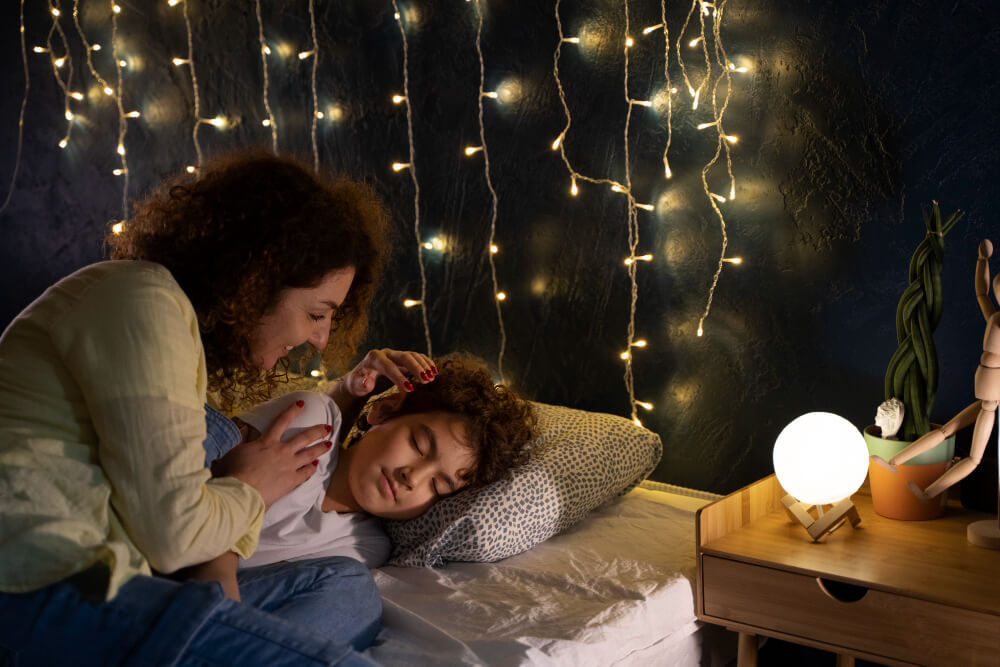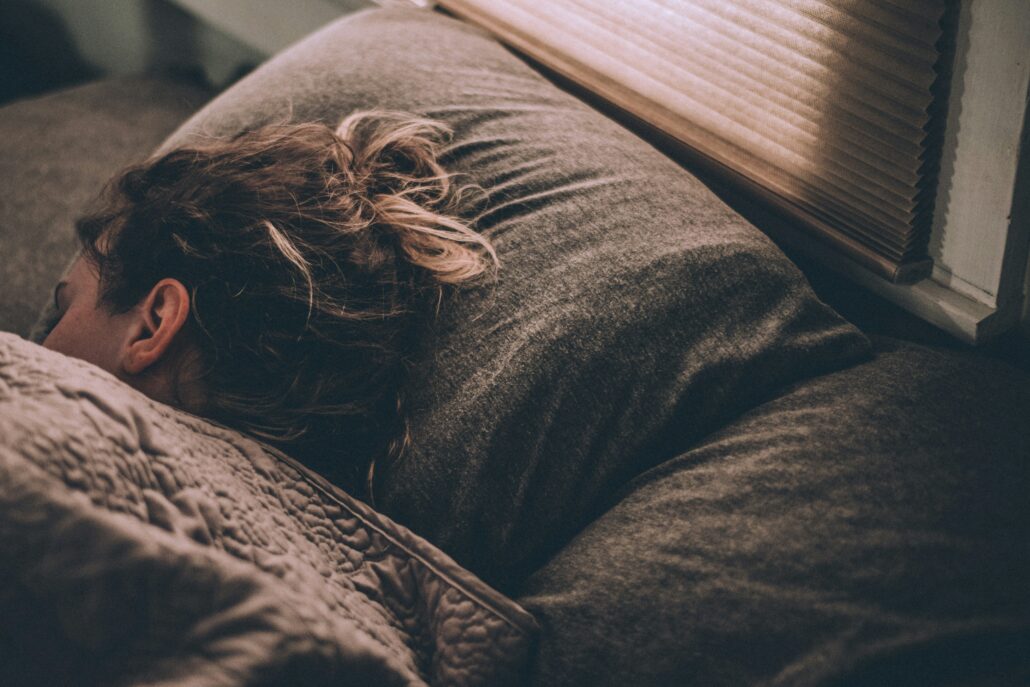7 Simple Ways to Transform Your Bedroom Into a Restful Sleep Environment
Quality sleep is essential for your overall health and wellbeing. Reaching the goal of a good night’s sleep involves changing lifestyle habits, focusing on sleep hygiene, and, among other things, creating a peaceful bedroom that invites and promotes sleep.
Your body and mind take cues from your activities and surroundings to recognize that it’s time to sleep. If your space isn’t projecting the calm and tranquility you desire, read on for seven practical tips to transform any bedroom into a serene and restful sanctuary, perfect for promoting better sleep.
#1 – Declutter and Simplify
An unorganized space filled with clutter could be better for relaxation and sleep. Research shows a relationship between clutter and mental health challenges such as depression, anxiety, and stress, and sleeping in a messy bedroom can cause frustration, overwhelm, and helplessness. On the other hand, decluttering your bedroom can help you create healthy sleeping habits, boost your mood, promote relaxation, and improve your sleep.
Decluttering Steps
- One Area or Type: Don’t be afraid to start small! Tackle just your closet on day one and your dresser another day. Or you could start with the decor in your bedroom before moving to a collection of throws. Whatever you decide to designate, be sure you can complete the project in an hour or two so you won’t sleep in a more cluttered bedroom than before.
- Find Function: Now is a good time to think about how you want to use your space. Do you always leave clothes hanging over a chair? A coat rack might help. Or perhaps there’s always a table full of junk mail. Try designating a space in your hallway instead. The goal is to identify frequently cluttered areas and find a better way to utilize existing spaces.
- Start at the Bottom: You need to be able to move around your bedroom freely during the decluttering process. Put any items such as shoes and clothes where they should go. If they don’t have space, this might require a shopping trip for new hangers or an over-the-door shoe rack.
- Pick-a-Pile: This next step is a little harder because you’re designating things to keep or get rid of. You could start with just those two piles or add others such as store, donate, recycle, and trash.
Energize Your Space with Feng Shui
While you’re decluttering and simplifying, this is the perfect time to make some adjustment to the energy in your bedroom so you sleep better and stress less by using a technique called Feng shui. Here are some simple suggestions to bring feng shui into your bedroom:
- Size Up Your Space: The size of your bed matters when practicing feng shui. Your bedroom and mattress should be the right size so you can fully relax and sleep comfortably through the night. If the size of your mattress doesn’t seem right, consider replacing your mattress.
- Position Your Bed Correctly: Your bed should be placed in a “commanding position” so you can see the door of your bedroom. This positioning creates a sense of safety and stability.
- Be Mindful of Circulation: Energy should circulate freely around and under your bed and throughout the room. Remove any excess clutter that impedes the energy flow of your bedroom.
- Choose Soothing Décor: Colors that you see in nature elevate the feng shui energy. Think blue, greens, and browns. Warm colors work great, but try to avoid bright reds, pinks, or oranges.
- Focus on Comfort: The temperature of your bedroom should be between 65 and 67 degrees Farhrenheit. A space that is too hot or too cold will interfere with feng shui’s energy. Finish adding fung shui to your space with black out window treatments, a comfortable mattress, and pure cotton, breathable bedding.
#2 – Choose a Soothing Color Palette
Did you know that some colors trigger physiological and psychological reactions? For example, blues can represent the sea or sky and are considered calm or serene. Other harmonious colors for bedrooms that can create a sleep-friendly bedroom and their meanings are:
- Green: Tranquility, rest, and renewal
- Light Gray/White: Peace and clean; can make the room feel larger
- Beige/Cream: Warm and inviting
- Light Pink: Comfort and warmth
On the other hand, the following shades can cause you to have a less restful night’s sleep:
- Red: Energy, passion, and aggression; can raise blood pressure
- Black: Dramatic and intense; can make the room feel smaller
- Purple: Overstimulating
- Dark Brown: Gloomy and heavy
- Bright Yellow/Orange: Stimulating and exciting
Of course, the goal with color is to create a relaxing and comfortable space, so don’t hesitate to try out your favorite color or consider using it as an accent color.
#3 – Upgrade Your Bedding
According to a Better Sleep Council survey, 72% of U.S. adults say comfort is the most important thing they look for in a new mattress. Therefore, using the bulk of your bedroom budget to invest in a high-quality mattress and bedding makes good sense.
If your current mattress isn’t comfortable for you (or your partner) or is more than seven years old, it’s time to replace it. To get the most bang for your buck, take the S.L.E.E.P. Test during your mattress shopping trip:
- Select a mattress.
- Lie down in your typical sleep position.
- Evaluate the level of comfort and support.
- Educate yourself about each selection.
- Partners should test beds together.
Like your mattress, bedding is essential for good sleep hygiene, and the materials you choose for your bedding should be comfortable and relaxing. For example, sheets with high thread counts are typically softer and more luxurious than those with lower thread counts. Down is considered a soft and cozy filling for pillows, while memory foam or latex is firmer and more supportive. Incorporating natural materials such as wood, cotton, and linen to bring a sense of tranquility and connection to nature, which we’ll cover next.
#4 – Connect with Nature
Exposure to nature is associated with improved cognitive function, brain activity, blood pressure, mental health, physical activity, and sleep. Houseplants are one of the most common ways to bring a touch of nature indoors and improve your sleep environment, and some varieties help purify air. Houseplants need exposure to light, whether through a window or artificial lighting. Observe how the light moves throughout your bedroom at different times of the day to find good spots for your plants. Here are a few suggestions to get you started:
- ZZ plant
- Flamingo plant
- Lady palm
- Pothos
- Monstera deliciosa
- Phalaenopsis orchid
- Echeveria
- Peace lily
- Spider plant
- Snake plant
Bringing nature into your bedroom isn’t the only way to reap the benefits. “Surrounding greenness” means any green space, such as urban gardens and tree-lined streets. 92% of people who had contact with surrounding greenness reported being more likely to sleep well at night. If your bedroom isn’t conducive to houseplants, an evening stroll through your neighborhood is another option.
#5 Sound and Scent
Sleep disturbances, hormonal changes, chronic health conditions, and cardiovascular events are linked to environmental noise, particularly from traffic, and there’s no question that a quiet environment helps you sleep better. Fortunately, there are numerous options to drown out environmental noise outside and inside your bedroom, such as:
- Sound Machines
- White or Pink Noise
- Noise Canceling Headphones
- Relaxing Playlists
- Guided Meditation Apps
Remember, unless you’re using an app on your phone or tablet to help you sleep or for an alarm, it’s best to put it away or in another room to avoid notifications that disturb your sleep.
Just as certain sounds set the mood for sleep, scents signal your body and mind that it’s time to get ready for bed. You can use essential oils and aromatherapy diffusers to create a personalized scent profile for your sleeping environment. Lavender, cedarwood, and bergamot are scents that encourage better sleep.
#6 Create a Relaxation Nook
There’s a good chance that you’ll find extra space in your bedroom after it’s decluttered. If so, why not turn it into a calm and relaxing nook for reading and other quiet activities? Bonus points if you use a corner or space that was once your go-to for dumping unorganized things!
First, select a cozy chair or consider adding bench seating. Occasional chairs, glider rockers, swivel chairs, or recliners are all good options for quiet nooks. Now, you can accessorize with a footstool, side table, and reading light. The great thing about a nook is that it doesn’t have to flow with the rest of the room. Separating your nook with color or a partition makes it even cozier. The goal is to infuse the space with a calming ambiance.
#7 – Choose the Right Lighting
Lighting plays a vital role in healthy sleep patterns. Exposure to sunlight during the day helps program your sleep-wake cycles, but light exposure at night makes it difficult to switch from awake to asleep.Artificial light at night (ALAN) suppresses melatonin secretion, and increases sleep onset latency and alertness. ALAN can also negatively affect psychological, cardiovascular, and metabolic functions.
However, it’s not realistic to have a pitch-dark bedroom all of the time. Here are some suggestions for creating layers to light up your sleep environment – both day and night:
- Ambient Lighting: Ambient light includes natural lighting from windows or artificial lighting that illuminates your entire space so you can complete daily tasks. Ceiling fixtures and floor lamps are types of ambient lights.
- Task Lighting: Task lighting is commonly used for activities that require more concentration. If you read in bed at night or work at a desk in the corner of your room, you probably have a task light to help you focus. Task lights come in a number of types, including desk lights, table lamps, swing-arm lamps, sconces, and wall-mounted lights.
- Accent Lighting: As the name implies, accent lighting draws attention to or highlights a feature, often with a warm, cozy glow. Recessed lights, wall sconces, and tape lights are popular accent lighting types in bedrooms.
Dimmer switches and lightbulbs control the amount of light in the bedroom. Dimmers allow you to transition from a bright light during the day to a lower light before bed. However, many of the popular compact Fluorescent Lamps (CFLs) and some low-voltage LED bulbs are difficult to control with a basic dimmer switch or can emit a buzzing sound. If you control your lighting without a dimmer, look for lightbulbs with a lumen, or brightness, between 25 and 100 watts.
Improving your sleep environment is an investment in your health – and a way to prioritize self-care with a personal touch in one of the most essential spaces in your home. For even more tips, check out Extreme Remake: Bedroom Edition, our guide to an ideal bedroom!



